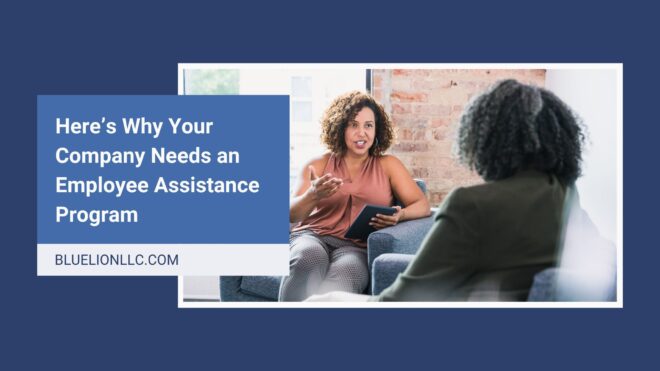
Today’s workers are stressed out and anxious.
With the World Health Organization (WHO) naming stress the health epidemic of the 21st century, it’s no surprise that both personal and professional stress permeates so many corners of our lives.
This is why it is so important for companies to implement Employee Assistance Programs (EAPs). An EAP can be an essential resource for employees who are dealing with a range of issues.
Unfortunately, these valuable programs are underused, with only 5 out of every 100 employees with access to an EAP leveraging the benefit in a year. However, usage has doubled since the COVID-19 pandemic—which makes sense when you consider how employee stress has skyrocketed over the last few years.
It seems employees typically have two main concerns regarding EAPs:
- There is often a stigma because, historically, it was primarily a resource for people with substance misuse problems or serious mental health issues.
- Employees are reluctant to use EAP counseling due to confidentiality concerns.
Modern EAPs, however, address a much broader range of problems and are always 100% confidential. They can offer significant assistance to your workforce and, in turn, have very positive effects on your company.
If your organization does not already have one in place, we highly recommend getting one! Below, we’ll tell you:
- Exactly what an EAP is and what it covers
- Why your company needs one
- How to implement one effectively
Keep reading for the low-down on EAPs so you can get one in place today.
What is an Employee Assistance Program (EAP)?
An employee assistance program or plan is a voluntary work-based intervention program designed to offer employees support and solutions for issues impacting both their work and personal lives. It is employer-sponsored and completely free for employees to use.
Employee assistance program services can include counseling and guidance for areas such as:
- Marital/relationship problems
- Financial struggles
- Emotional problems
- Family issues
- Substance or alcohol misuse
Some EAPs may even offer a wide range of services covering basic legal assistance and referrals, adoption assistance, help finding elder care services, and more. It is separate but complementary to your other employee wellness programs, as your provider can often help you find related wellness offerings. The employee’s spouse, children, or partner living in the same household also typically have access to the EAP.
Program counselors will work in a consultative role with managers and supervisors to address employee and organizational challenges and needs. This means they can help organizations prevent and cope with workplace violence, trauma, and other emergency response situations.
Why does your company need an EAP?
EAPs are great for employees because they are paid for by employers and often extend to employees’ immediate family members or to anyone living in employees’ homes. On the same token, EAPs are cost-effective tools for employers that can truly pay off long-term.
As an employer, you have a vested interest in your employees’ performance. If they are distracted and affected by personal issues and stress, it can affect their ability to reach their full potential. This, in turn, can hurt productivity and drive up costs for businesses.
EAPs cover certain needs that the healthcare system can’t handle, like financial counseling or elder care assistance. People often struggle with these areas silently simply because they don’t know where to turn for help or can’t afford it. Again, these are totally free services to employees.
EAPs can be the key to helping employees deal with these types of issues and significantly improving their performance.
The Stress is in the Numbers
Are you still unsure if your workplace really needs an EAP?
The State of the Global Workplace: 2023 Report by Gallup found that employee stress remains at a record high for the second year in a row, with 52% of American and Canadian respondents stating they experienced a lot of stress the previous day.
While employee stress has likely risen partially due to the pandemic, it’s been increasing for over a decade. Gallup also found that 26% of U.S. employees “very often or always” feel burned out at work, and only 24% feel their employer cares about their well-being.
So, how does workplace stress impact your business? When your employees are struggling with excessive stress or other mental health issues, it can:
- Interfere with employee focus, engagement, and productivity
- Cause performance issues, such as mistakes or missed deadlines
- Decrease morale and create a tense work environment
- Increase tardiness, absenteeism, and turnover
- Spark workplace conflicts between coworkers and/or staff and supervisors
- Lead to more illnesses and injuries—which can, in turn, affect your insurance rates
According to the American Institute of Stress, around 1 million workers are absent every day due to stress, and this job stress is estimated to cost American companies “more than $300 billion in losses due to absenteeism, diminished productivity, and accidents.”
Those are some ugly stats—and there are many more regarding the negative effects of stress in the workplace.
Employee Assistance Program Benefits
Fortunately, employers can prevent and address many stress-related problems by properly implementing an EAP with resources to help employees manage their stress. The U.S. Department of Health and Human Services reports that for every dollar invested in an EAP, employers generally save anywhere from $5 to $16.
Are you concerned about the costs of adding an EAP to your employee benefits package? Statistics show that only 1-2% of employees need to use it for counseling each year “to yield enough savings in work productivity outcomes” to break even on your ROI!
But an effective EAP is about more than a purely financial return on investment. It can help:
- Reduce absenteeism
- Boost employee engagement
- Improve job performance and productivity
- Decrease presenteeism
- Ease depression and promote mental health
- Support employees in recovery
- Attract and retain talent
One study even found that employee satisfaction regarding EAPs is “often over 90%.” Additional research found that these programs can strengthen the company from a bigger-picture perspective because they provide “consulting to managers and leaders, workplace crisis preparedness and incident response, organizational level behavioral health risk management services, and specialists for difficult workplace events (i.e., harassment, bullying, sexual inappropriate behavior, customer conflicts, work team dysfunction).”
How can you implement an EAP?
If you’re ready to get an EAP for your business, we recommend first asking your employee benefits broker if they offer one. Oftentimes (but not always), short-term and long-term disability providers offer this to employers at no cost!
When searching for an EAP, you will want to evaluate what kind of program will best suit your organization’s needs. A few things to consider include what the plan provides, how EAP contracts work, critical requirements any EAP should follow, and how employees will access EAP services.
EAP Delivery Options
There are a number of options when it comes to how an EAP is managed and delivered. Businesses can choose to keep it in-house or outsource all services. The Society for Human Resource Management (SHRM) reports that the most common EAP delivery models include:
- Management-sponsored EAPs: Employers (often large organizations) hire internal EAP staff to deliver the services all in-house.
- Fixed-fee contracts: Employers pay for various services (i.e., counseling, referrals, and supervisory training) with fees based on the number of employees, regardless of their actual EAP use.
- Fee-for-service contracts: Employers contract an EAP provider and pay only when the service is used.
- Consortia: Small businesses join together to contract for EAP services, lowering the cost per employee.
- Member assistance programs: Unions provide these programs with services ranging from prevention and problem identification to referral and counseling activities for employees and their family members.
- Peer assistance programs: PAPs are sponsored by employers or unions and train peers to work with troubled employees to address substance abuse and other problems within predetermined rules and limits.
- Mixed-model programs: These are used by employers and unions with multiple worksites that have different needs and resources.
Service Options
Another awesome benefit of EAPs is that many of them offer different forms of in-person and e-counseling. These include tele-counseling and video-counseling, which suit the needs of many professionals who live a hectic lifestyle and are looking for a more convenient, practical alternative. Virtual counseling eliminates travel time and offers more scheduling flexibility.
Many EAP providers offer both e-counseling and in-person counseling. This allows the client to choose what works best for them. In some cases, a blended approach is taken based on the employee’s needs. This means the employee can enjoy the benefits each method has to offer.
Communication
Once an EAP is in place, employers and/or their HR teams need to inform employees about it regularly (ideally on a monthly basis). This way, all employees will be aware of the program’s existence, how it works, and their options.
Be sure to communicate the comprehensive services included in the EAP during these routine reminders. Let workers know that they are free and available to everyone in the company. By properly educating all employees about the program, you can remove the stigma around EAPs and encourage them to take advantage of it.
Confidentiality
Another important factor to address is confidentiality. Remind employees that any services they seek through the EAP are kept completely confidential.
Employees don’t need to get permission or go through HR to utilize the services. All they have to do is contact the EAP provider. Counselors do not report back to the organization nor keep external records of the counseling sessions. No one in the company has to know that the employee is receiving assistance.
Executing an Employee Assistance Program
It will be up to your HR team to manage your organization’s employee assistance program and the relationship with your EAP provider, but the use of the services will always stay confidential.
HR will need to stay in contact with the EAP provider to ensure the programs in place are effective and to guarantee the timely and accurate flow of information to employees. This will help the organization develop services over time and encourage employee engagement with the programs. It only makes sense that HR should be involved since an EAP is an investment in your people!
If your company needs assistance implementing and maintaining an EAP, contact BlueLion at 603-818-4131 or info@bluelionllc.com today. From finding the perfect program for your business to creating policies and procedures, we’ll help you get started on the right track toward ensuring your employees’ well-being and productivity.
The information on this website, including its newsletters, is not, nor is it intended to be legal advice. You should contact an attorney or HR specialist for advice on your individual situation.
This article was originally published in May 2020 and has been updated for accuracy and comprehensiveness.


